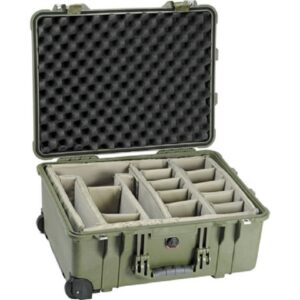
We can create durable transit cases by using rigid structures and a variety of impact-resistant features.
Transit cases play a crucial role in protecting valuable and sensitive equipment, but they lead a hard life. Transit cases often bang together in the backs of cargo trucks, may be dropped, and take knocks from all directions. Yet their users expect cases to be able to shrug off this abuse and contain sensitive items without issue. This is why transit case manufacturers, such as Packaging Strategies, Inc., must know how to create strong and durable transit cases that can withstand the rigors of shipping, handling, and environmental factors. Case manufacturers can balance the requirements of durable cases through their chosen materials, structural design, hardware, sealing, and impact-resistant features.
Materials Selection
Manufacturers must choose case materials that are lightweight yet strong, impact-resistant, and durable enough to withstand extreme temperatures and moisture. Commonly used materials for strong and durable transit cases include polypropylene, aluminum, and high-density polyethylene (HDPE).
Rigid Structural Design
The structure of a transit case plays a key role in its durability and strength. Manufacturers must consider the stresses and forces the case will undergo during transportation and design a case to suit those settings. Features like reinforced corners, interlocking ribs, and a double-wall construction can enhance the strength of a case.
Recessed areas in the case also create places where handles, tie-down rings, latches, and hinges can sit without being exposed to impact damage. Larger cases designed to be lifted by a forklift may also have additional reinforcements where the forks are inserted.
Hardware and Fasteners
The hardware used to create durable transit cases must be strong enough to withstand repeated opening and closing and shock and vibrations during transportation. Installing hardware should also be undertaken carefully. For instance, rather than securing the hardware directly to the case material, fasteners that go through the case to metal inserts mounted on the interior wall will spread the load over a larger area. Selecting hardware from materials such as stainless steel or high-strength plastics can ensure that this part of the case can withstand the rigors of transportation and use.
Sealing and Gasketing
Transit cases must be able to keep their contents safe, including protecting the items from even a drop of water or speck of dust or sand. Using sealing and gaskets that can withstand extreme temperatures, humidity, and dust, is essential. Features like tongue-and-groove gaskets, neoprene gaskets, and pressure relief valves can help enhance the sealing capabilities of durable transit cases.
Impact-Resistant Features
Transit cases must be able to protect their contents from impacts during transportation. Case manufacturers can engineer impact-resistant features such as shock-absorbing foam, adjustable padded dividers, and customizable foam inserts to hold and protect equipment from movement, shocks, and vibrations.
By following these guidelines, manufacturers can create strong and durable transit cases that can withstand all rigors of transportation.
DEPEND ON PACKAGING STRATEGIES FOR YOUR CUSTOM PACKAGING NEEDS
Packaging Strategies has assembled a team with over 100 years of experience in design, engineering, development, manufacturing, and sales. We created the Packaging Strategies Design and Technology Center to create and manufacture complete systems integration packages and container solutions of all sizes and materials for our clientele. Many of these clients are federal agencies or in the private sector. No matter what you need to carry, Packaging Strategies is sure to have the right case for the job. You can view our website here, and follow us on Facebook, Twitter, Flickr, and LinkedIn.
This entry was posted on Tuesday, May 2nd, 2023 at 9:00 am. You can follow any responses to this entry through the RSS 2.0 feed. You can leave a response, or trackback from your own site.